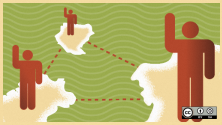Opensource.com exists to educate the world about everything open source, from new tools and frameworks to scaling communities. We aim to make open source more accessible to anyone who wants to use or contribute to it.
Getting started in open source can be hard, so we regularly share tips and advice on how you can get involved. If you want to learn Python, help fight COVID-19, or join the Kubernetes community, we've got you covered.
To help you begin, we curated the 10 most popular articles on getting started in open source we published in 2020. We hope they'll inspire you to learn something new in 2021.
A beginner's guide to web scraping with Python
Want to learn Python through doing, not reading? In this tutorial, Julia Piaskowski guides you through her first web scraping project in Python. She shows how to access webpage content with Python library requests.
Julia walks through each step, from installing Python 3 to cleaning web scraping results with pandas. Aided by screenshots galore, she explains how to scrape with an end goal in mind.
The section on extracting relevant content is especially helpful; she doesn't mince words when saying this can be tough. But, like the rest of the article, she guides you through each step.
A beginner's guide to SSH for remote connections on Linux
If you've never opened a secure shell (SSH) before, the first time can be confusing. In this tutorial, Seth Kenlon shows how to configure two computers for SSH connections and securely connect them without a password.
From four key phrases you should know to steps for activating SSH on each host, Seth explains every step of making SSH connections. He includes advice on finding your computer's IP address, creating an SSH key, and verifying your access to a remote machine.
5 steps to learn any programming language
If you know one programming language, you can learn them all. That's the premise of this article by Seth Kenlon, which argues that knowing some basic programming logic can scale across languages.
Seth shares five things programmers look for when considering a new language to learn to code in. Syntax, built-ins, and parsers are among the five, and he accompanies each with steps to take action.
The key argument uniting them all? Once you know the theory of how code works, it scales across languages. Nothing is too hard for you to learn.
Contribute to open source healthcare projects for COVID-19
Did you know that an Italian hospital saved COVID-19 patients' lives by 3D printing valves for reanimation devices? It's one of many ways open source contributors built solutions for the pandemic in 2020.
In this article, Joshua Pearce shares several ways to volunteer with open source projects addressing COVID-19. While Project Open Air is the largest, Joshua explains how you can also work on a wiki for an open source ventilator, write open source COVID-19 medical supply requirements, test an open source oxygen concentrator prototype, and more.
Advice for getting started with GNOME
GNOME is one of the most popular Linux desktops, but is it right for you? This article shares advice from GNOME users interspersed with Opensource.com's take on this topic.
Want some inspiration for configuring your desktop? This article includes links to get started with GNOME extensions, installing Dash to Dock, using the GNOME Tweak tool, and more.
After all that, you might decide that GNOME still isn't for you—and that's cool. You'll find links to other Linux desktops and window managers at the end.
3 reasons to contribute to open source now
As of June 2020, GitHub hosted more than 180,000 public repositories. It's never been easier to join the open source community, but does that mean you should? In this article, Opensource.com Correspondent Jason Blais shares three reasons to take the plunge.
Contributing to open source can boost your confidence, resume, and professional network. Jason explains how to leverage your contributions in helpful detail, from sharing how to add open source contributions on your LinkedIn profile to turning these contributions into paid roles. There's even a list of great projects for first-time contributors at the end.
4 ways I contribute to open source as a Linux systems administrator
Sysadmins are the unsung heroes of open source. They do lots of work behind the code that's deeply valuable but often unseen.
In this article, Elizabeth K. Joseph explains how she improves open source projects as a Linux sysadmin. User support, hosting project resources, and finding new website environments are just a few ways she leaves communities better than she found them.
Perhaps the most crucial contribution of all? Documentation! Elizabeth got her start in open source rewriting a quickstart guide for a project she used. Submitting bugs and patch reports to projects you use often is an ideal way to get involved.
6 ways to contribute to an open source alternative to Slack
Mattermost is a popular platform for teams that want an open source messaging system. Its active, vibrant community is a key plus that keeps users loyal to the product, especially those with experience in Go, React, and DevOps.
If you'd like to contribute to Mattermost, Jason Blais explains how. Consider this article your Getting Started documentation: Blais shares steps to take, organized by six types of contributions you can make.
Whether you'd like to build an integration or localize your language, this article shares how to get going.
How to contribute to Kubernetes
I walked into Open Source Summit 2018 in Vancouver young and unaware of Kubernetes. After the keynotes, I walked out of the ballroom a changed-yet-confused woman. It's not hyperbole to say that Kubernetes has changed open source for good: It's tough to find a more popular, impactful project.
If you'd like to contribute, IBM Engineer Tara Gu explains how she got started. This recap of her lightning talk at All Things Open 2019 includes a video of the talk she gave in person. At a conference. Remember those…?
How anyone can contribute to open source software in their job
Necessity is the mother of invention, especially in open source. Many folks build open source solutions to their own problems. But what happens when developers miss the mark by building products without gathering feedback from their target users?
Product and design teams often fill this gap in enterprises. What should developers do if such roles don't exist on their open source teams?
In this article, Catherine Robson explains how open source teams can collect feedback from their target users. It's written for folks who want to share their work experiences with developers, thus contributing their feedback to open source projects.
The steps Catherine outlines will help you share your insights with open source teams and play a key role helping teams build better products.
What do you want to learn?
What would you like to know about getting started in open source? Please share your suggestions for article topics in the comments. And if you have a story to share to help others get started in open source, please consider writing an article for Opensource.com.







Comments are closed.